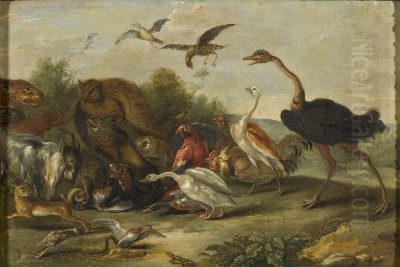
Jan van Kessel the Elder stands as a prominent figure in the rich tapestry of 17th-century Flemish Baroque painting. Active primarily in Antwerp, he carved a unique niche for himself, specializing in meticulously detailed depictions of the natural world. Born into an extraordinary artistic dynasty, Van Kessel became renowned for his jewel-like paintings of insects, flowers, shells, and allegorical subjects, often executed on a small scale with breathtaking precision. His work bridges the gap between artistic tradition and the burgeoning scientific curiosity of his age, offering viewers intricate glimpses into the wonders of creation. Esteemed during his lifetime and highly sought after by collectors then and now, Van Kessel's legacy endures in the delicate beauty and encyclopedic scope of his art.
Early Life and Artistic Lineage
Jan van Kessel was born in Antwerp in 1626, baptized on April 5th of that year. His entry into the world placed him directly within one of the most influential artistic families in European history. His mother, Paschasia Brueghel, was the daughter of Jan Brueghel the Elder (1568-1625), famously known as "Velvet" Brueghel for his refined technique and luminous surfaces. This made Jan van Kessel the Elder the grandson of Jan Brueghel the Elder and the great-grandson of the legendary Pieter Bruegel the Elder (c. 1525-1569), the patriarch of the Bruegel dynasty and a pivotal figure in the Northern Renaissance.
His father was Hieronymus van Kessel the Younger, also a painter, though less famous than his Brueghel in-laws. Furthermore, Jan van Kessel's uncle was Jan Brueghel the Younger (1601-1678), who took over his father's successful workshop and continued the family tradition of detailed landscapes and still lifes. Another significant family connection came through marriage: his aunt, Anna Brueghel (daughter of Jan the Elder), married David Teniers the Younger (1610-1690), one of the most versatile and prolific Flemish painters of the era. Growing up surrounded by such immense talent and artistic activity undoubtedly provided Van Kessel with unparalleled exposure to technique, subject matter, and the business of art from a very young age. This environment fostered his innate talent and set the stage for his own distinguished career.
Training and Guild Membership
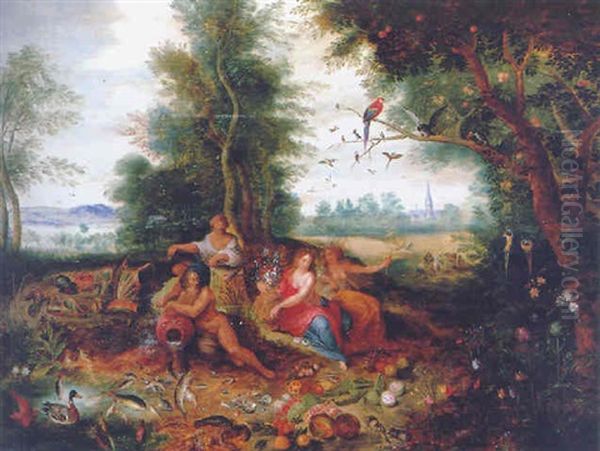
Formal artistic training was a natural path for young Jan. He began his apprenticeship around 1634 or 1635. His primary master was the history painter Simon de Vos (1603-1676). While De Vos was known for larger-scale historical and genre scenes, this training would have provided Van Kessel with a solid foundation in drawing, composition, and the handling of pigments. It is interesting to note that Van Kessel ultimately specialized in a genre quite different from that of his official master, suggesting a strong personal inclination towards the detailed observation of nature, likely nurtured by his Brueghel heritage.
Alongside his formal apprenticeship, Van Kessel undoubtedly received significant guidance and influence from his uncle, Jan Brueghel the Younger. The family workshop was a hub of activity, and records indicate that Jan Brueghel the Younger sometimes employed his nephew. For instance, it's documented that the younger Brueghel paid his nephew in 1646 for making copies of some paintings, indicating an established working relationship and the uncle's trust in Van Kessel's abilities. This close connection to the Brueghel workshop tradition was crucial in shaping Van Kessel's meticulous style and his choice of subject matter, particularly flower pieces and detailed natural studies. He successfully completed his training and was registered as a master in the Antwerp Guild of St. Luke in the guild year 1644/1645, signifying his independence as an artist. Membership in the prestigious Guild was essential for practicing professionally in Antwerp, allowing him to take on pupils and sell his work openly.
Artistic Style: Precision and Vibrancy
Jan van Kessel the Elder is celebrated for a distinctive artistic style characterized by extraordinary precision, vibrant color, and often, a miniature scale. His works frequently feel like precious objects, inviting close inspection to appreciate the incredible level of detail. He possessed a remarkable ability to render the varied textures and iridescent sheens of insect wings, the delicate veins of flower petals, the intricate patterns of shells, and the soft plumage of birds with almost scientific accuracy. This meticulousness aligns him closely with the tradition established by his grandfather, Jan Brueghel the Elder, but Van Kessel developed his own unique approach.
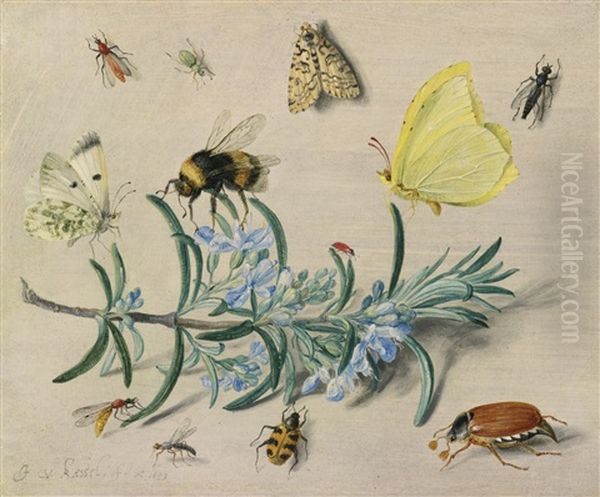
Many of Van Kessel's most characteristic works were painted on copper panels. This smooth, non-absorbent surface was ideal for his technique, allowing for fine brushwork without the texture of canvas interfering. Painting on copper enhanced the luminosity of his pigments, giving his works an enamel-like brilliance and contributing to their jewel-like quality. His palette was typically bright and varied, employing clear, saturated colors that brought his natural subjects to life. While his compositions are generally balanced and aesthetically pleasing, some contemporary and later accounts noted that his depiction of human figures, when included (often in allegorical works), could be somewhat stiff or less accomplished than his masterful rendering of flora and fauna. This sometimes led him to collaborate with other artists who would paint the figures within his compositions, a common practice in Antwerp at the time.
Thematic Focus: Nature Observed and Allegorized
The core of Jan van Kessel's oeuvre lies in the depiction of the natural world. He was a master of still life, particularly compositions featuring flowers, fruits, and, most distinctively, insects. His studies of butterflies, beetles, dragonflies, spiders, and caterpillars are rendered with such accuracy that they often seem like pages from an entomologist's handbook, yet they are always arranged with an artist's eye for composition and color harmony. These works reflect the era's growing interest in natural history and the collection of exotic specimens, fueled by global exploration and scientific inquiry.
Beyond straightforward still lifes, Van Kessel frequently explored allegorical and symbolic themes. He produced several series representing the Four Elements (Earth, Air, Fire, Water), often depicted through carefully chosen assortments of animals, plants, and objects associated with each element. Similarly, he painted allegories of the Five Senses (Sight, Smell, Hearing, Taste, Touch) and the Four Continents (Europe, Asia, Africa, America), again using natural specimens and symbolic objects to convey complex ideas. These allegorical works often took the form of central painted scenes surrounded by numerous smaller compartments, each containing a meticulously rendered detail related to the theme.
His small, detailed paintings were perfectly suited for inclusion in Kunstkammern or 'cabinets of curiosities'. These were collections, popular among European elites, that assembled natural wonders (shells, minerals, taxidermy) alongside man-made objects (scientific instruments, artworks, ethnographic items) to represent a microcosm of the known world. Van Kessel's paintings, with their encyclopedic approach to nature, functioned as artistic contributions to these collections, celebrating both the diversity of creation and human ability to study and represent it. He also painted Vanitas still lifes, which included symbolic objects like skulls, hourglasses, and wilting flowers to remind viewers of the transience of life and earthly pleasures.
Key Influences and Contemporaries
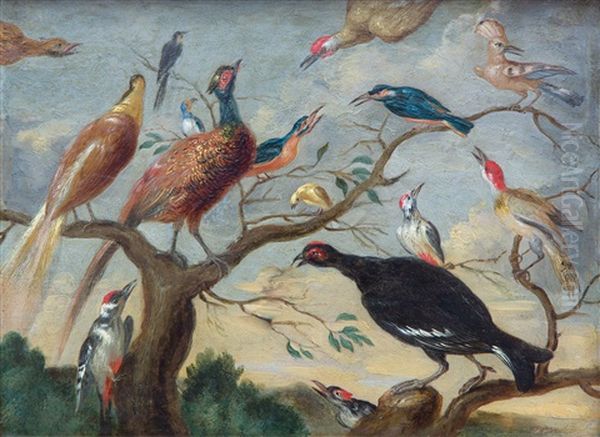
Jan van Kessel's art was deeply rooted in the Flemish tradition, yet it also absorbed contemporary trends. His most formative influence was undoubtedly his grandfather, Jan Brueghel the Elder, whose pioneering work in flower painting and allegorical landscapes set a high standard for detail and refinement. Van Kessel inherited the Brueghelian love for meticulous rendering and luminous color. His uncle, Jan Brueghel the Younger, provided direct continuity and guidance in this tradition.
Beyond his family, Van Kessel looked to other artists specializing in detailed nature studies. The work of Joris Hoefnagel (1542-1600), a slightly earlier Flemish artist renowned for his exquisite manuscript illuminations and natural history illustrations, was a significant source of inspiration. Hoefnagel's scientific yet artistic approach to depicting insects and plants clearly resonated with Van Kessel. The influence of Roelandt Savery (1576-1639), known for his lush landscapes populated with exotic animals and detailed flower paintings, can also be discerned.
Within the bustling Antwerp art scene, Van Kessel was a contemporary of several other notable still life painters. Frans Snyders (1579-1657), a master of large-scale market scenes and hunting still lifes, represented a different, more robust approach to the genre, but his skill in depicting animals was widely admired. Daniel Seghers (1590-1661), a Jesuit painter famous for his flower cartouches often surrounding religious scenes or portraits by other artists, was another leading figure in Antwerp flower painting. Although their styles differed, the presence of such accomplished specialists fostered a competitive yet stimulating environment. Occasionally, Van Kessel might have collaborated with figure painters like Erasmus Quellinus II (1607-1678), a student of Peter Paul Rubens (1577-1640), the towering figure who dominated Antwerp's art world. While Van Kessel's intimate style contrasts sharply with Rubens' dynamism, the Brueghel family connection placed him within the broader orbit of Antwerp's artistic elite.
Representative Works
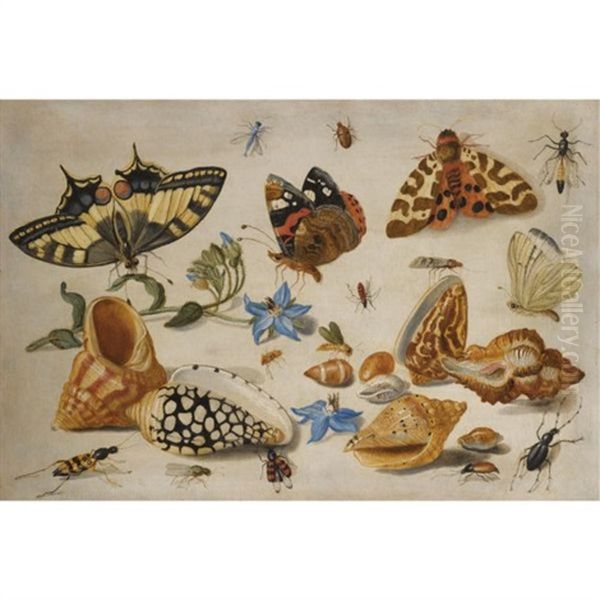
Jan van Kessel the Elder's prolific output includes many works that exemplify his unique talents. Among his most celebrated creations are the allegorical series. His depictions of The Four Elements are tours de force of detailed observation, with each panel teeming with creatures and objects representing Earth (mammals, reptiles, minerals), Air (birds, insects), Water (fish, shells, amphibians), and Fire (objects related to smithing, warfare, or salamanders, then believed to live in fire). Similarly, his series on the Four Continents (or Parts of the World) used exotic animals, local artifacts, and symbolic figures to represent Europe, Asia, Africa, and America, reflecting the 17th-century European worldview and fascination with global diversity. A notable example is The Continent of Europe (c. 1664-1666), part of a larger series now housed in the Museo Nacional del Prado, Madrid.
His individual insect and flower studies are perhaps his most characteristic works. Paintings like Insects and a Sprig of Rosemary (National Gallery of Art, Washington D.C.) or Butterflies, Caterpillars, and Insects with Sprays of Common Carnation and Forget-me-not (1654, Ashmolean Museum, Oxford) showcase his ability to render minute details with scientific precision on small copper panels. These works often isolate specimens against a plain light background, emphasizing their form and color.
Van Kessel also created Vanitas still lifes, such as the one dated around 1670 (Musée du Louvre, Paris), which combines traditional symbols of mortality like a skull and bubbles with meticulously painted flowers and insects, creating a poignant contrast between fleeting beauty and inevitable decay. Bird paintings were another specialty, ranging from ornithologically accurate studies to more imaginative compositions like A Concert of Birds or The Mockery of the Owl, where various birds gather around an owl, a theme with roots in medieval fables. Works like Shells and Insects or Apples, Hazelnuts, Grapes, and a Melon further demonstrate his versatility within the still life genre, always marked by his signature precision and vibrant palette.
Later Life, Family, and Legacy
In 1647, Jan van Kessel married Maria van Apshoven. The couple had thirteen children, ensuring the continuation of the family line. Two of his sons, Jan van Kessel the Younger (1654-1708) and Ferdinand van Kessel (1648-1696), became painters themselves, working in styles closely related to their father's, sometimes leading to attribution difficulties between their works. Jan van Kessel the Younger, in particular, achieved considerable success, even working for the royal court in Spain. Beyond his artistic life, Jan van Kessel the Elder was integrated into Antwerp's civic society; records show he served as a captain in the local civic guard (Schutterij), a position indicating a degree of social standing.

Despite his artistic success and reputation, which brought commissions from patrons across Europe, Jan van Kessel the Elder faced financial difficulties later in life. The reasons for this are not entirely clear but may relate to the economic downturns affecting Antwerp or perhaps personal financial mismanagement. Sadly, when he died in Antwerp on April 17, 1679, at the age of 53, he was heavily in debt. His wife was forced to mortgage their home to cover the debts, a somber end for such a talented and respected artist.
Nevertheless, Jan van Kessel the Elder's artistic legacy was secure. His unique blend of the Brueghelian tradition with an almost scientific approach to natural history made his work highly distinctive. He influenced subsequent generations of still life painters, particularly those specializing in detailed studies of insects and flowers. His paintings were avidly collected during his lifetime and have remained highly prized ever since. Today, his works can be found in major museums around the world, including the Museo Nacional del Prado in Madrid, the Musée du Louvre in Paris, the National Gallery in London, the Metropolitan Museum of Art in New York, the National Gallery of Art in Washington D.C., the Rijksmuseum in Amsterdam, the Ashmolean Museum in Oxford, the Fitzwilliam Museum in Cambridge, and the Royal Museums of Fine Arts of Belgium in Brussels, among many others.
Conclusion
Jan van Kessel the Elder occupies a significant place in the history of Flemish art. As an heir to the illustrious Brueghel dynasty, he skillfully adapted and personalized the family's tradition of meticulous detail and vibrant color. His specialization in the miniature world of insects, flowers, and shells, rendered with unparalleled precision often on luminous copper panels, captured the 17th-century fascination with both the beauty and the scientific order of nature. Through his still lifes and intricate allegorical series, he created captivating microcosms that continue to delight and intrigue viewers. Despite the financial hardships that marked his final years, his artistic contribution remains undiminished. Jan van Kessel the Elder endures as a master observer, a brilliant technician, and a unique voice within the golden age of Flemish painting, whose exquisite works offer enduring windows onto the wonders of the natural world.